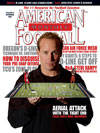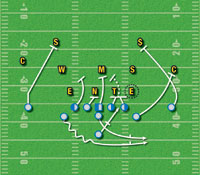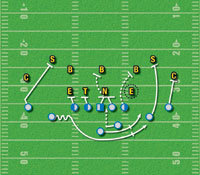AMERICAN FOOTBALL MONTHLY THE #1 RESOURCE FOR FOOTBALL COACHES
Article CategoriesAFM Magazine
|
Meshing the Option with the West Coast OffenseHow the Air Force Academy plans to blend two distinct offenses.by: Mike Kuchar © More from this issue Not unlike the other service academies, when it came to running the football, the United States Air Force Academy prided itself on executing a balanced, three-back option attack. Focusing on four to five yards a carry – their patented scheme would burn up the clock and wear down its opponents. It was that ‘three yards and a cloud of dust’ mentality that former head coach Fisher DeBerry preached to his cadets for the 23 years of his reign giving them a chance to compete against bigger, stronger and faster opponents. But with new head coach Troy Calhoun now taking over reigns in Colorado Springs, the Falcons have changed their tune. Intent with getting the ball downfield in a hurry and in the hands of their better athletes, Calhoun has tweaked the Falcons previous offensive system into more of a spread attack. He’ll still be utilizing the triple, or veer option scheme, but he’ll be running it more out of a shotgun, yes shotgun formation. It’s the first time ever in a practice or game situation that Air Force used the formation. “I just felt that with the speed of defenses today, you have to get the ball going north and south not east and west. Anytime you are going to play on a consistent basis with the same type of run action, your opponents will draw a pretty good bead on what you’re doing assignment wise,” said Calhoun. “You may catch someone by surprise once in a while, but you don’t have a consistent chance of being successful.” The Veer Scheme During the last ten days of spring football, aside from developing a three and five step passing game, the Falcons installed a veer scheme out of single back sets. The major difference was in the QB’s mesh with the running back. In a traditional veer option scheme out of a double slot formation (See Diagram 1) the QB will open up a four o’clock path to the playside if it is option right and an eight o’clock path if it is option left. The QB will be responsible for setting the mesh point with the fullback who gives a soft pocket for the football at his jersey numbers. While the QB’s hands extend the ball to the FB, his eyes will read the numbers of the dive defender, the first defender outside the B gap, usually a defensive tackle or end. If that defender collapses his shoulders toward the fullback, the QB gets a pull read, keeping the ball and carrying out the option with the slot back. If the QB sees the defender’s shoulders move up field, he gets a give read, seating the ball right in the FB’s numbers but still carrying out the option fake with the slot back.
What Calhoun and his staff were able to do this spring is keep the same fundamentals of running the veer scheme, but run it out of various formations; he installed up to twenty different sets so far. The scheme stayed the same, just the personnel changed. “A traditional Air Force team in double slot would play a defense and see up to eleven guys in the box all geared up to stop the run. Now you don’t have to be stubborn enough to try and run the ball up in there. Just by formation, you’re getting the defense to cover the entire field. When defenses do that there are always open areas to exploit and run the ball through,” said Jemal Singleton, the Falcons running back coach. Using the Shotgun Out of a shotgun, two-back set (See Diagram 2) the Falcons will keep their veer option principles intact. The difference is the QB, who now at five yards depth, must be able to seat the ball to the fullback at a much different angle. He still keeps his eyes on the backside dive defender – in this case the defensive end. Because it is extremely difficult to do both (seat the ball and keep his eyes on the dive defender) in a shotgun formation, the fullback is now responsible for the mesh. Already a yard in front of the QB, he must take a slide step playside and give a pocket for the QB to seat the football. The running track of the fullback becomes more of an A gap angle. “The FB gets right into the playside A gap; we let him come right across the toes of the QB,” says Calhoun. “It’s the teaching of the track that you have to work on, the ball handling is already in place. What you have to master is now there is a separate track between under center and in the gun. For the offensive line everything is the same and we keep it real simple for them. We’re still reading the 5-technique area.”
On the snap, while the FB is running his track and setting a soft squeeze for the QB, the tailback is already getting into pitch phase relationship. If the QB gets a pull read from the dive defender, he is going to work down the line with the TB and option the next defender out. “If we’re under center our pitch phase is five yards deep and three yards behind the QB. Anytime we’re pitching out the shotgun it’s three yards deep and five yards behind,” says Calhoun. The offensive line to the backside of the play works to scoop or cutoff their defender while the frontside leaves the first defender outside the B gap unblocked. One-Back Shotgun Set The Falcons can still work the same veer scheme in a one-back shotgun set (See Diagram 3). Known as quads, most defenses will expect a pass tendency out of a four wide receiver formation and could leave only five run defenders in the box. This is when an option scheme can be most effective; they’re already not blocking two defenders at the point of attack (the dive and pitch defenders) so the offense has a tremendous numbers advantage to run the football. The FB will keep the same track, being responsible for the mesh point with the QB. The offensive line still blocks their traditional veer blocking scheme leaving the dive defender – in this case the defensive end – unblocked. The difference is with no tailback in the formation, the backside slot, who is usually four yards removed outside the offensive tackle, now becomes the pitch player. Calhoun will either run a twirl motion track, putting him into a tailback relationship pre-snap or start on the snap to get to pitch relationship.
“You can’t be too predictable as an offense. The key is being able to run what you run well but do it out of different looks. The scheme stays the same but you present it to the defense differently. You have to be able to do it out of a shotgun to spread the field,” says Calhoun. “So now you get a receiver involved to become the pitch player. There is no difference whether that TB or WR becomes the pitch man. We would use the WR when there is only one back, the fullback, on the field. You have to have a way where the wide receiver becomes the second back either by alignment or motioning him into the backfield.” Using False Motion Once he sees defenses over-adjusting to twirl motion, expecting option to the side of the motion, Calhoun will add another wrinkle to his scheme by using false motion by the slot. In a twins flank, one back formation (See Diagram 4) Calhoun will start to cheat the backside slot by using twirl motion pre-snap. But by the time the center snaps the football, instead of getting in a pitch relationship away from the side of the motion, the slot will plant his inside foot, pivot, then get to pitch relationship to the side that he just motioned from. This will get the entire defense to shift to the side away from the motion, leaving a voided alley to the motion side. “We’ll go ahead and twirl it just to see how that defensive secondary is rotating. It they are working towards the strong side, you work the triple option right back to where the motion started,” said Calhoun.
Although you may add some diversity to the veer option scheme this way by running it out of different formations, Calhoun still believes in keeping it as simple as possible – that means making a commitment to the fundamentals of the option scheme. The Falcons have what they call a ‘ride and decide’ period every practice for five to ten minutes daily. All they do in this period is work the triple option meshes with the QB and the running back from both the shotgun and under center. Repetition is perhaps the greatest form of education and Calhoun is making sure that his players get plenty of reps during practice to avoid major mishaps during games. “There is some great stuff you can draw up on the chalk board but execution-wise as soon as you start doing too much you’re going to hurt yourself. You can’t dabble in the option scheme; it takes a tremendous commitment from staff and players alike. Adding wrinkles that defenses have to prepare for is a major advantage. But as soon as we feel we’re doing too much, we’ll stop.” |
|
| HOME |
MAGAZINE |
SUBSCRIBE | ONLINE COLUMNISTS | COACHING VIDEOS |
Copyright 2024, AmericanFootballMonthly.com
All Rights Reserved








